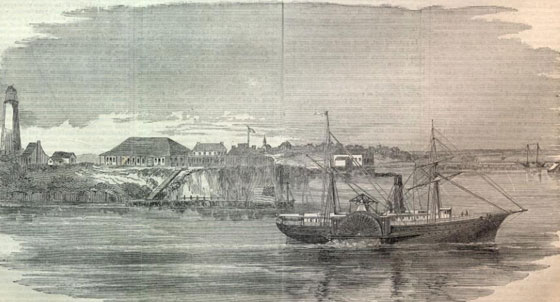Point Isabel
Formerly known as El Fronton, Point Isabel had been a major commercial center before the Civil War era. Its significance was marked in 1852 by the construction of a major lighthouse to guide ships through the Brazos Santiago pass, the tallest structure in the vicinity. Although the town declined in importance after steam technology made safe passage directly into the Rio Grande possible, the lighthouse served as a beacon for small Confederate trade ships that used the port to avoid the Union blockade. When Union troops occupied South Texas in 1863, the Confederates attempted to blow up the lighthouse to prevent it from being used as an enemy observation post, but their efforts failed: they only damaged the top part. When Confederates recaptured the Rio Grande Valley in the summer of 1864, they pushed the Union troops back to Brazos Island and kept a close watch from the nearby Point to guard against an amphibious landing. The most significant clash between the two forces came on August 9 at the Point Isabel docks when 250 Confederate cavalrymen skirmished with 75 men of the Corps of African Engineers—a unit of black freedmen from Louisiana. In March 1865, U.S. General Lew Wallace, who later gained fame as a governor of the New Mexico territory and author of the bestselling historical novel Ben Hur, met here with rebel leaders James Slaughter and John S. “Rip” Ford to discuss a cease fire for the Rio Grande delta. Although they reached no formal arrangement, they did agree to an informal truce, which lasted until hostilities again broke out at Palmito Ranch.
Listen
Conocida con anterioridad como «El Frontón», Punta de Santa Isabel había sido un centro de comercio de gran importancia antes de la época de la Guerra de Secesión estadounidense. Su relevancia vino marcada en 1852 por la construcción de un faro de grandes dimensiones (la estructura más alta en todos los alrededores) para guiar a las embarcaciones a través del paso de Brazos Santiago. Aunque la importancia de la población menguó después de que la tecnología del vapor posibilitó un tránsito seguro directamente hacia las aguas del Río Grande, el faro siguió utilizándose como señal marítima para las embarcaciones de menor calado que utilizaban el puerto para burlar el bloqueo unionista. Cuando las fuerzas de la Unión ocuparon el Sur de Texas en 1863, los confederados intentaron volar el faro para evitar que se convirtiera en un punto de observación del enemigo, pero no lo consiguieron, dañando sólo la parte superior del mismo. Cuando los confederados recuperaron El Valle del Río Grande en el verano de 1864, repelieron a los unionistas hasta la Isla de Brazos, y establecieron una estrecha vigilancia desde la cercana Punta de Santa Isabel para evitar un posible desembarco anfibio. El choque más importante entre los contendientes tuvo lugar el 9 de agosto en los embarcaderos de Punta de Santa Isabel, en forma de una escaramuza entre 250 unidades de caballería confederada y 75 hombres del Cuerpo de Zapadores Africanos –una unidad de esclavos liberados de La Luisiana. En marzo de 1865, el General del Ejército de los Estados Unidos Lew Wallace, quien luego ganara fama como gobernador del territorio de Nuevo México y como autor de la exitosa novela histórica Ben Hur, se reunió aquí con los mandos rebeldes James Slaughter y John S. «Rip» Ford para negociar un alto el fuego en el delta del Río Grande. Aunque no se llegó a un acuerdo formal, sí se estableció una tregua informal que se mantuvo hasta que las hostilidades estallaron de nuevo en el Rancho Palmito.
Escucha
Details
Location:
Museum of Port Isabel
317 E. Railroad Avenue
Port Isabel, TX 78578
Access: Access to the grounds of the Port Isabel lighthouse require no admission.
Contact: Jeannie Flores, Port Isabel Museums Director at (956) 943-7602

